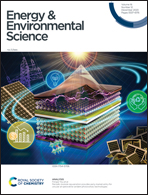Screening potential anodic chemistry in lieu of the oxygen evolution reaction in electrolysis systems: the road to practical application
Abstract
Electrolysis systems transform electrical energy to chemical energy, providing a pathway for renewable electricity power to value-added chemicals. A wide range of cathodic electrochemical reactions, including hydrogen evolution reaction, electrochemical reduction of carbon dioxide, and electrochemical hydrogenation of organic compounds, are explored for the production of chemicals using electrolysis systems. However, the anodic reaction normally coupled in the system—the oxygen evolution reaction, is less economically profitable based on the high energy consumption of the reaction and less valuable oxygen produced. Moreover, the crossover of oxygen may be detrimental to electrolytic systems sensitive to oxidants. As such, discovering potential alternative anodic chemistry in electrolysis systems, which includes the upgrading of chemicals and degradation of pollutants, may reinvigorate the associated electrochemical industries. In this perspective, explorations in this field are discussed predicated on the electrocatalytic mechanism, and the design of catalysts and reactors, motivating further studies on the optimization of the whole system towards practical application.



 Please wait while we load your content...
Please wait while we load your content...